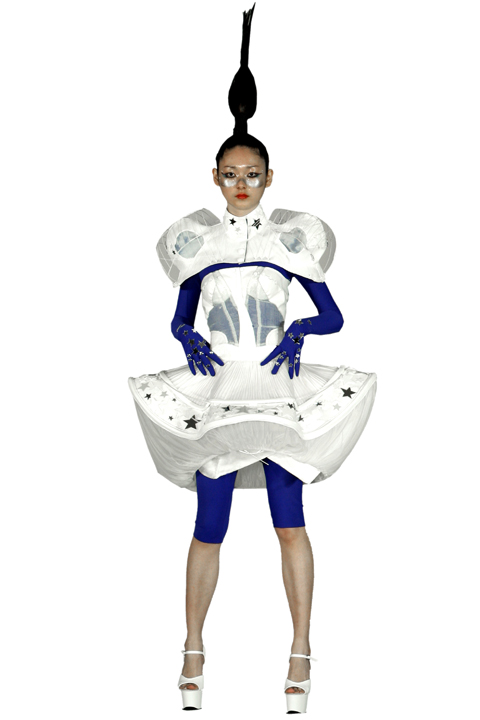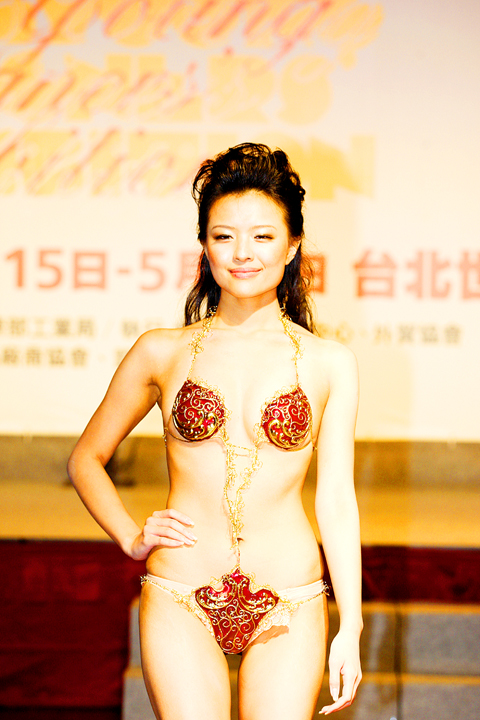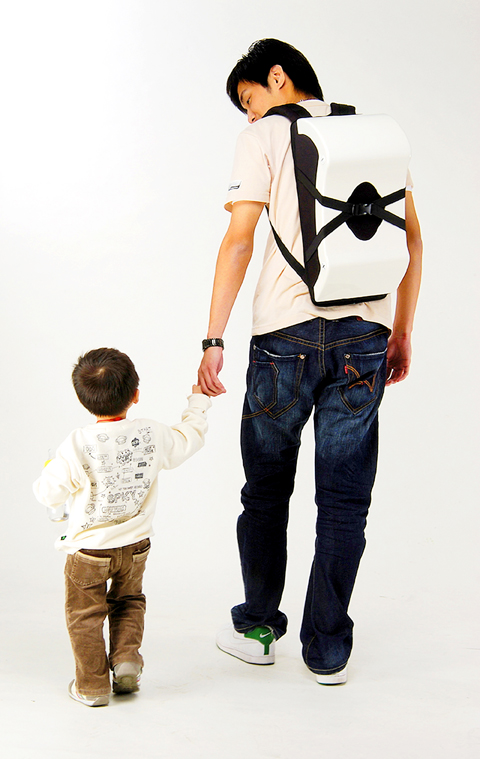A matching jewelry set for pet and owner, a sofa-seat built into a suitcase, a Renaissance-inspired bikini — these are just a few of the many creations by Taiwanese design students on display tomorrow at the 2008 Young Designers’ Exhibition (YODEX), which runs until May 18 at the Taipei World Trade Center.
“It’s the only event that design schools [in Taiwan] look forward to every year,” says Kristy Cha Ray Chu (曲家瑞), director of Shih Chien University’s (實踐大學) Institute of Fashion and Communications Design.
Now in its 27th year, YODEX is one of the world’s largest exhibition fairs for design students and new graduates. It continues to grow: the fair attracted 80,000 visitors last year, and this year organizers are expecting that number to rise to 100,000.

PHOTO: COURTESY OF WINNIE CHENG AND TAIWAN DESIGN CENTER
Chu says many visitors to the exhibition are high school students, making YODEX a prime recruiting ground for design schools. Several dozen Taiwanese design schools and universities will have a presence at YODEX this year running booths and exhibitions.
The global presence at the event has grown in recent years, according to Steffy Sun (孫善蓉) of the Taiwan Design Center (台灣創意設計中心), which organizes YODEX. Twenty schools from Australia, the UK, the US and Italy will be represented at this year’s exhibition.
YODEX’s growth reflects a changing demographic: more Taiwanese students want to study design, according to Chu. Design colleges and universities are seeing more applicants from Taiwan’s top high schools, she says, resulting in better work. Chu notes that 10 years ago, students tended to stick to the “technical” aspects of design, but today they are “more creative” and “more brave” in their work.

PHOTO: COURTESY OF WINNIE CHENG AND TAIWAN DESIGN CENTER
The following are a few of the works on display at YODEX this year, which range from the practical to the extravagant:
Lee Heng’s (李恆) “pet charms” is a set of matching jewelry collars for pets and their owners. The loose-fitting collars extend into the shape of a heart and are made of a rose-gold copper alloy. The heart shape is adorned with intricate patterns cut using techniques derived from Chinese paper cutting, while the collar is enameled with gold. Lee, a senior at the National Hsinchu University of Education (新竹教育大學) and self-proclaimed pet-lover, says he wanted to make something that would be “the topic of conversation.”
Another highly ornamented design is found in Huang Pin-shiuan’s (黃品璇) The Poolside Pavane, a bikini inspired by the clothes worn by European aristocracy when dancing the pavane, a processional dance performed in the 16th and 17th centuries. Huang, a student at Fu Jen Catholic University (輔仁大學), wrote in a statement that her design was inspired by the era’s sense of “nobility” and “boldness of expression” of one’s wealth.

PHOTO: COURTESY OF WINNIE CHENG AND TAIWAN DESIGN CENTER
And for weary travelers, there’s luggage that doubles as a seat. The aptly-named BAGGAGE TAKE A SEAT! by Winnie Cheng (鄭羽珊), an industrial design student at Huafan University (華梵大學), is a suitcase with a built-in sofa cushion. Fashion-conscious users can use removable plates to change the suitcase’s color.
YODEX 2008 launches with an opening ceremony tomorrow at 10:30am. The festivities include a performance by Taiwanese indie-rock band Tizzy Bac. During the exhibition, YODEX is also holding its Young Designers’ Competition for the fields of packaging design, industrial design, visual communication, multimedia and handicrafts. The winners will be announced at an awards ceremony on May 17 at 2pm. There will also be a series of discussion forums and lectures throughout the exhibition (held in Mandarin Chinese only). Check YODEX’s Web site for details.

PHOTO: COURTESY OF WINNIE CHENG AND TAIWAN DESIGN CENTER

PHOTO: COURTESY OF WINNIE CHENG AND TAIWAN DESIGN CENTER

On April 26, The Lancet published a letter from two doctors at Taichung-based China Medical University Hospital (CMUH) warning that “Taiwan’s Health Care System is on the Brink of Collapse.” The authors said that “Years of policy inaction and mismanagement of resources have led to the National Health Insurance system operating under unsustainable conditions.” The pushback was immediate. Errors in the paper were quickly identified and publicized, to discredit the authors (the hospital apologized). CNA reported that CMUH said the letter described Taiwan in 2021 as having 62 nurses per 10,000 people, when the correct number was 78 nurses per 10,000

May 5 to May 11 What started out as friction between Taiwanese students at Taichung First High School and a Japanese head cook escalated dramatically over the first two weeks of May 1927. It began on April 30 when the cook’s wife knew that lotus starch used in that night’s dinner had rat feces in it, but failed to inform staff until the meal was already prepared. The students believed that her silence was intentional, and filed a complaint. The school’s Japanese administrators sided with the cook’s family, dismissing the students as troublemakers and clamping down on their freedoms — with

As Donald Trump’s executive order in March led to the shuttering of Voice of America (VOA) — the global broadcaster whose roots date back to the fight against Nazi propaganda — he quickly attracted support from figures not used to aligning themselves with any US administration. Trump had ordered the US Agency for Global Media, the federal agency that funds VOA and other groups promoting independent journalism overseas, to be “eliminated to the maximum extent consistent with applicable law.” The decision suddenly halted programming in 49 languages to more than 425 million people. In Moscow, Margarita Simonyan, the hardline editor-in-chief of the

Six weeks before I embarked on a research mission in Kyoto, I was sitting alone at a bar counter in Melbourne. Next to me, a woman was bragging loudly to a friend: She, too, was heading to Kyoto, I quickly discerned. Except her trip was in four months. And she’d just pulled an all-nighter booking restaurant reservations. As I snooped on the conversation, I broke out in a sweat, panicking because I’d yet to secure a single table. Then I remembered: Eating well in Japan is absolutely not something to lose sleep over. It’s true that the best-known institutions book up faster